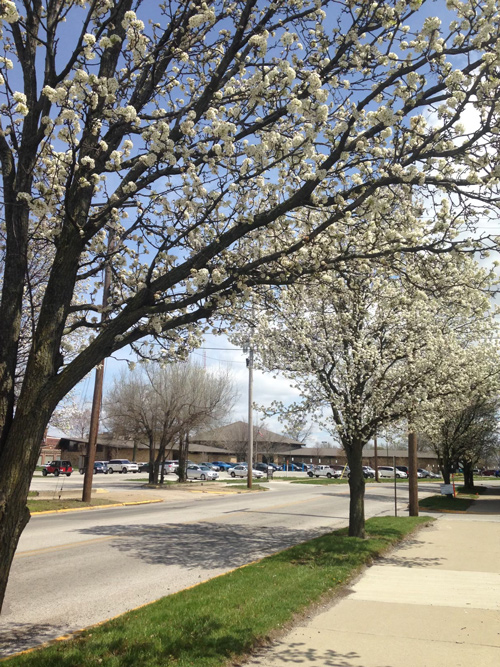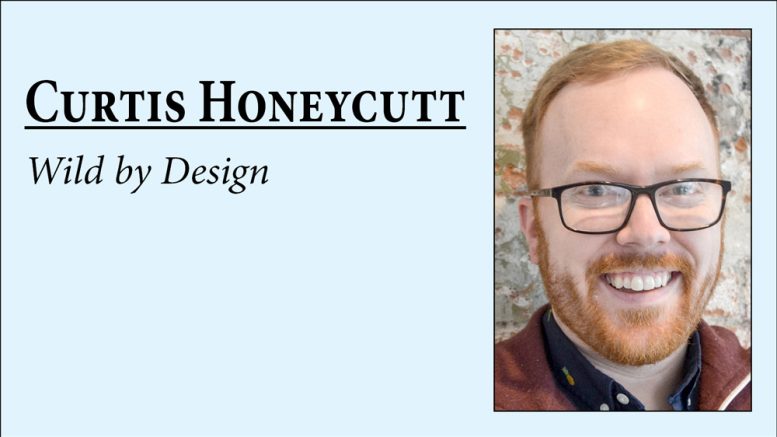Our old house was in a nice Fishers subdivision built in the late 1990s. Every house had a matching mailbox, prompt snowplowing services and – of course – a Callery (Bradford pear is the most popular variety) pear tree in the front yard. These trees, native to China and Vietnam, are quick-growing and look nice as their white blossoms bloom in the spring (as long as you don’t mind that distinctive rotten fish smell).
There are a few essential and super-practical issues with these trees. First, the limbs all split from the same place, creating a wall for windstorms to blow down. This happened to our Callery pear and we had to cut the rest of it down and haul it away. The second, and more important, issue with Callery pears is they are an invasive species.
An invasive plant species is any plant non-native to an area whose presence causes environmental or economic harm or harm to human health. Callery pear trees spread along roadways and into natural areas through reseeding. They are invasive because they form dense thickets that can push out other plants, including native species. Plants growing in the thickets can’t tolerate the deep shade or compete with the pear tree for water, soil and space. In short, these trees are the scourge of the suburbs.
The Callery pear tree is such a problem that the Hamilton County Invasives Partnership (HIP) has declared it as one of its “Dirty Dozen” invasive species (more on that later). During April, you can participate in your home landscape as well as local parks as part of HIP’s Invasive Species Action Month.

Photo courtesy Hamilton County Soil & Water Conservation District
If you have an invasive species growing in your yard (examples include the aforementioned Callery pear, burning bush, and Japanese barberry), you can apply to swap it out for a free native tree or shrub from the Hamilton County Soil and Water Conservation District. All you need to do is submit before-and-after-removal photos with the application to be considered. Applications are due Sept. 5 at hcinvasives.org/trade.
During Invasive Species Awareness Month, you can also improve natural areas in your community. Two Weed Wrangle events remain this month: Tuesday, April 16 at River Heritage Park in Carmel and Saturday, April 20 at Cheeney Creek in Fishers. Weed Wrangles are volunteer invasive species removal events hosted nationwide to control the invasive plants negatively impacting our public parks, green spaces, and natural areas. Volunteers will learn how to manage the targeted invasive species and get to work as part of a collaborative effort to improve a natural area.
If you want to roll up your sleeves a bit further, you can participate in a Strike Team workday on Saturday, April 27 at MacGregor Park in Westfield. Though similar in format to Weed Wrangles, Strike Team events typically involve a more rigorous hands-on approach to invasive control. You can register to volunteer for these events at hcinvasives.org/events.
How do you know if you have one of these plant pariahs in your yard? I like to use the Seek or iNaturalist apps on my phone for plant identification. However, those apps won’t tell you if a species is invasive – only if it is “native” or “introduced” to the area. You can do some quick online research to determine if your plant is invasive by searching the name of your plant along with “Indiana invasive,” and the top results will likely get things sorted out. However, if you’d like to consult a local expert, contacting the Hamilton County Soil and Water Conservation District can help you get your answer. I heard they even make the occasional house call.
The final Invasive Species Awareness Month event happens on Saturday, April 27 at 11 a.m., as HIP will present “The Dirty Dozen: Are These Invasive Plants in Your Yard?” at the Carmel Clay Public Library. You will see my foe the Callery pear on this list, plus others common to our home landscapes.
By eliminating invasive plants, we can restore the balance of the ecosystem, benefit native wildlife, save money, and create healthier and more enjoyable outdoor spaces in Hamilton County. So, go out in your yard and figure out what’s growing.
Curtis Honeycutt is a Noblesville-based columnist and author. Send him your questions, comments, and suggestions at curtis@curtishoneycutt.com.


Thank you SOOO much for writing this! Every piece of publicity that educates people about invasives is very valuable. By the way, do you know about the Indiana Native Plant Society? It’s a mostly volunteer non-profit that educates the public about native plants, invasives, etc.; holds plant sales; gives hikes and programs, and generally promotes native plants. I highly recommend it.